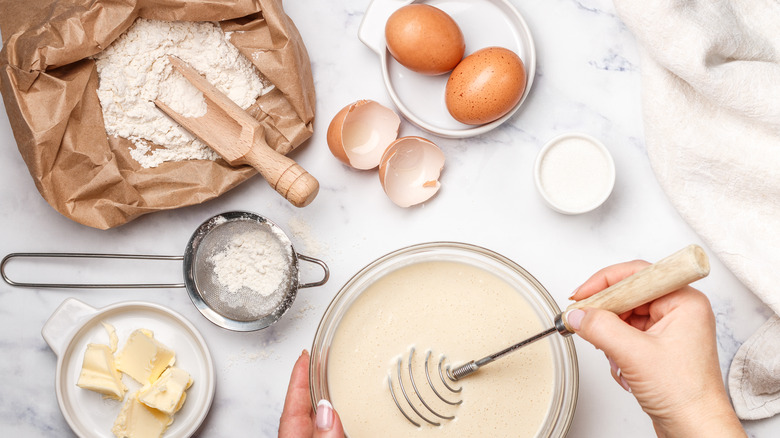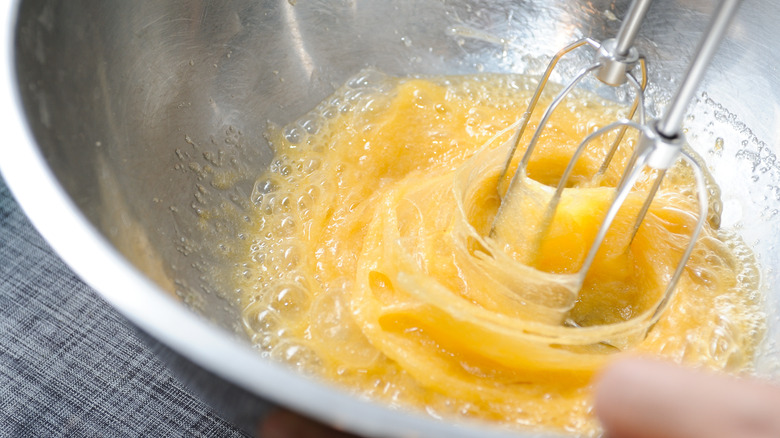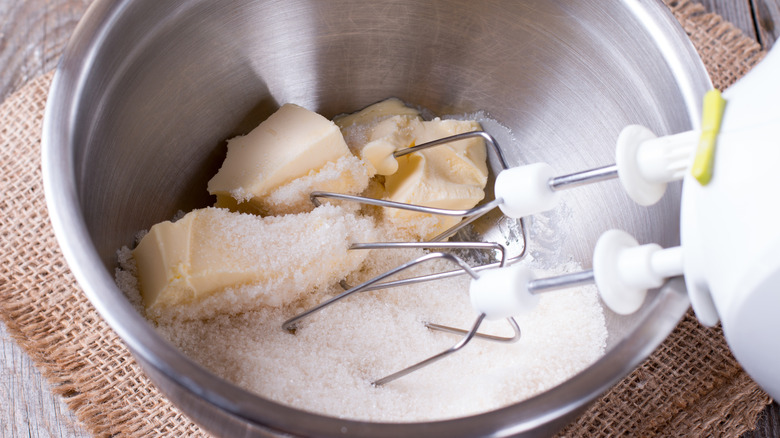Why You Shouldn't Make Cupcakes With Cold Eggs And Butter
Perfect for cake lovers and foodies driven by a sweet tooth or two, cupcakes offer a convenient and delectable single-serving of their large and traditionally layered counterpart, delivering the satisfying taste of cake without the hassle of having to slice it and plate it. Since first making their debut in American bakeries in the late 1700s (per The Hummingbird Bakery), cupcakes have evolved to take on more complex flavors and creative presentations — but the taste of a cupcake and how it looks is moot if the texture of the cake is not fluffy and light.
As Spoon University explains, a cupcake's fluffiness is dependent upon the pockets of air that are created or trapped when certain leavening agents interact within the batter. While the chemical reactions seen by baking soda and baking powder in cake batter are responsible for most of the air pockets that build up to produce a well-risen, spongy cupcake, there are other key ingredients like eggs and butter that further aerate the batter. The temperature of these ingredients when added to the batter, however, can make or break the baked result.
At room temperature, eggs whip up much easier
According to Food 52, a baker's success in yielding a pillowy cupcake is dependent on how well the cupcake's liquid ingredients emulsify (or, how evenly they distribute) when combined. When eggs and butter are creamed together at room temperature, the fat particles from both the eggs and butter emulsify with the water from the egg whites to form a silky smooth batter (via Taste of Home). When one of the ingredients is too cold, however, the fat particles within the batter congeal into solid curds, resulting in a stubbornly lumpy or stiff batter (via Food 52).
Celebrity pastry chef Jacques Torres explained to Food Network the importance of lowering an egg's temperature before adding it to cake batter by demonstrating how egg whites (one of the leavening agents found in cupcakes) develop more volume when whipped at room temperature as compared to when whipped cold, which contributes to a fluffier cupcake. This could be because the contents found within an egg's shell are easier to disturb when at room temperature, as compared to when chilled (via Taste of Home). Eggs that have been set out for at least one to two hours are ideal for baking. However, if you are in a pinch and only have cold eggs on hand, try Jacques' method of setting your (whole) eggs to soak in a bowl of warm water for a few minutes (via Food Network).
Room temperature butter is essential for the creaming process
As Food 52 explains, the list of ingredients that should be brought to room temperature before being incorporated into cake batter goes beyond eggs to include butter, milk, and any other dairy or high-fat product typically stored in the fridge or freezer. Butter — specifically when softened to room temperature — is an essential ingredient in cake batter because of its unique ability to trap air when whipped (via Bon Appétit). Additionally, when softened butter is whipped with coarse sugar, the sugar crystals' jagged edges slice through the butter to create an abundance of little air pockets throughout the mixture; the longer these two ingredients are whipped, the more air bubbles are added to the cupcake batter, yielding fluffier results.
It is possible to over-do it on the mixing, though, as letting the mixer run for more than one to two minutes during the creaming process can easily result in too many air pockets trapped within the batter (via Sally's Baking Addiction). An excess of air bubbles will ultimately cause the cupcakes to deflate in the oven instead of rising. The risk of over-mixing can be reduced by ensuring the butter has been left resting at room-temperature for at least an hour or two, as doing so will allow the fat-rich ingredient to combine with sugar more efficiently during the creaming process.


